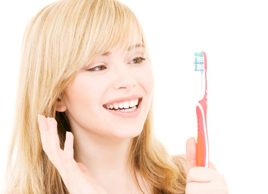How much do you know about toothbrushes?
Take this quiz to reveal how much you know about that bathroom sink fixture, the toothbrush

1. The best way to store your toothbrush is:
a) Lying on its back
b) With its bristles up
c) With its bristles down
d) It doesn’t matter, as long as you keep the head covered
Answer: b) With its bristles up. This is the best way to allow the toothbrush bristles to air-dry till its next use, thus keeping bacteria growth down. In fact, keeping your toothbrush head covered, or keeping the toothbrush in a closed container such as a travel holder is generally discouraged for the long term, as it allows microorganisms to breed, says the American Dental Association. In theory, storing a toothbrush on its back or even with its bristles down is fine, but the chances that it would be contaminated by touching a surface is greater in these scenarios.
2. You should replace your toothbrush
a) Every month
b) When the bristles are frayed
c) Every three months
d) Every six months
Answer: c) Every three months, according to the Canadian Dental Association. Don’t wait till your toothbrush’s bristles are frayed or splayed, either, as that indicates your toothbrush is past the point of replacement. As bristles become frayed and worn with use, they are less effective at cleaning your teeth.
3. Long before the modern toothbrush was invented, our predecessors cleaned their teeth with this tool:
a) A twig with a frayed end
b) A long, thin, curved metal stick
c) A hairbrush ‘ it was used for teeth and hair
d) They didn’t clean their teeth
Answer: a) A twig with a frayed end has been employed in oral hygiene since at least 3,000 B.C., according to the Library of Congress. Also called a ‘chew stick,’ this twig was rubbed against the teeth to clean them, and is still used in some parts of the world. Movie buffs may remember Gwyneth Paltrow’s lovelorn Elizabethan-era character using a twig to clean her teeth in Shakespeare in Love.
4. Small children should start brushing teeth when they are
a) Two years old and/or when all their teeth are in
b) As soon as they get their first tooth
c) One year old and/or when they have some teeth
d) Before they have teeth
Answer: d) Before they have teeth. Health care professionals always promote prevention, so it’s little surprise dentists encourage good oral hygiene almost from birth. Using a baby toothbrush or soft cloth, parents and caregivers should brush babies’ gums as early as is practical, introducing toothpaste at 6 months of age. ‘Before bed is the most important time to remove harmful germs from the teeth and gums, regardless of age,’ says Dr. Fred Ferguson in The Expert’s Guide to the Baby Years.
5. The bristle toothbrush was invented in
a) Morocco
b) China
c) Central America
d) Australia
Answer: b) China. Along with paper, kites and fireworks, the Chinese are credited with the invention of the bristle toothbrush, in 1498. The toothbrush handle was fashioned from either bone or bamboo, and its bristles came from the neck of a boar or hog. Boar bristle toothbrushes remained the standard until the nylon bristle was invented and mass-produced in 1938.
6. These early adopters of the toothbrush made the habit of brushing one’s teeth popular in America after World War II:
a) Teenagers
b) Nurses
c) European immigrants
d) Soldiers
Answer: d) Soldiers. Hard to believe, but the practice of brushing one’s teeth never truly caught on in America until soldiers brought the enforced habit home with them after WWII.
7. The advice to brush your teeth after every meal is
a) Outdated. With better cavity-fighting toothpastes and flosses on the market, you only need to brush twice a day
b) Still the recommendation of the Canadian Dental Association
c) Only valid if you’re using a manual toothbrush
d) Good advice, but geared toward keeping your smile white as opposed to preventing tooth decay
Answer: b) The Canadian Dental Association recommends brushing your teeth after every meal or, at the very minimum, before bedtime. The reason isn’t for fresh breath or to keep your smile whiter, but to eliminate harmful post-meal bacteria. ‘The bacterial attack on teeth begins minutes after eating,’ the organization warns. As for products that totally eliminate the need to brush? Don’t throw out the toothbrush with the tap water ‘ they’re not here yet, according to the CDA.




